Welcome to part two on Spanish and Latin American Culture and Language. Last time, we briefly discussed the history of Spanish and Latin American food around the world. In this entry, we’re going to focus more on the present, with an exploration of typical Spanish and Latin American food.
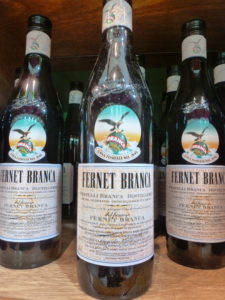
Fernet in Argentina
Traditional and Typical Spanish and Latin American Food
Traditional food is translated as comida típica (typical food) in the Spanish-speaking world. This contrasts the likeness of the traditional and the everyday in what are often developing countries with that of ‘traditional’ meaning ‘old’ in more developed ones.
Eating out in Latin America
Latin America has a range of foods you’ll find in markets, at food stands, bus terminals and in all kinds of restaurants.
We begin our virtual food tour in Mexico, where some typical dishes that you’re likely to encounter include the ever-present tacos. Tacos are nothing like the majority of tacos you’ll find in English-speaking countries. Made with corn flour (maiz de harina), tacos tend to be soft, and contain real chunks of meat (tacos al pastor), as opposed to ground beef. Shrimp tacos are also really popular.
In Central America, places like El Salvador offer their version of the taco. Pupusas are pieces of flat bread, again made with corn flour, and stuffed with fillings such as cheese and beans.
The Colombian and Venezuelan equivalent is the arepa, which is a harder, thicker type of tortilla, but toasted. Generally served with toppings like cheese on top in Colombia, the Venezuelans prefer to stuff theirs with anything from egg, to ground meat. There is also a northern Colombian version which contains an egg inside as well! Gallo pinto (translated as ‘speckled rooster’) is a dish of rice and beans found in Costa Rica, which goes by a variety of names in other Central American countries.
Ecuador, Peru and Chile
The Andean countries of Peru and Ecuador boast something you will not find commonly in other parts of the Americas – the cui, or guinea pig. Here, the cui is not a pet, but rather a bit of a food specialty. People either fry, roast or grill cui. It also comes complete with a look of surprise. Anticuchos are another classic, which are skewers of meat or heart, and are very common at street stalls throughout the country. Ceviche is perhaps one of the most famous dishes of the region, and consists of fish and other mixed seafood cooked in lemon juice.
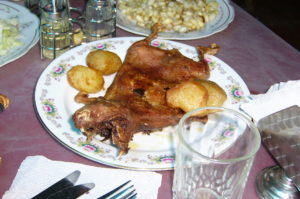
Fried guinea pig – street food, but also a specialty in some parts.
Peru, the Gastronomy Capital…
While found in Peru, Ecuador and Chile (and to a lesser degree in several other countries) ceviche is a real favourite from Peru, and has garnered international recognition alongside tacos and other famous Latin American foods. In fact, next to Mexico, Peru is one of the Latin American countries most famous for its food, and is quickly gaining a global audience.
An interesting side note is that Peru is the country responsible for bringing charcoal chicken and chips to the world. Known as pollo a la brasa, legend has it that a Peruvian introduced the idea of coal-cooked rotisserie chickens to Australia! No Melbourne high street would be incomplete without this Peruvian addition.
This gastronomical Andean country also has a famous drink known as pisco, a fermented grape spirit common at parties. There is much debate over which is the actual country of origin, as people enjoy pisco all over Peru and Chile. Still, peruvians and Chileans have often hotly-debated this point of contention! In Chile, you’ll find the omnipresent completo, a hotdog served with avocado and mayonnaise. Something you’re also likely to come across in this country is the churrasco, Chile’s answer to the steak sandwich!
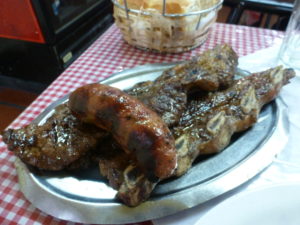
Argentinian parrillada
Argentina and Uruguay
These two countries are both famous for their sweets, which come in the form of alfajores (a type of shortbread) and of course facturas, a breakfast pastry with a clear European influence. Every heard of a media luna? Thats a half moon….or a croissant.
Another common dish found out and about is the milanesa, a type of chicken or beef schnitzel served with a number of toppings. After scoffing down a milanesa, you can head out and have a fernet or two (a fermented alcoholic drink made with herbs and spices). The flavour of fernet has been likened to a cross between liquorice mixed with toothpaste and alcohol. Yum! I personally love it, and the Argentines do too, especially with Coca Cola (called a fernetcola).
Last but not least is the Argentinian (and Uruguayan) BBQ, or parrillada. Salad lovers move along please…nothing to see here…
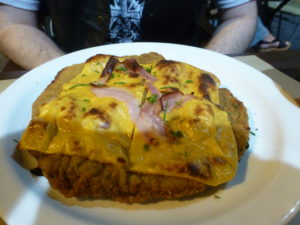
Milanesa de pollo (a type of schnitzel-type chicken dish)
Similarities between countries when eating out in Latin America.
The differences are numerous. For instance, fried green plantains are very common. They’re called tostones in Mexico and Central America, tachinos is Cuba, and patacones in Colombia, Venezuela and Ecuador.
Another common street food consists of corn or rice with meat or fish, wrapped and steamed in a banana leaf. This is called a tamal in Central America and Colombia, and hallacas in Venezuela. In Ecuador, Argentina, Peru, Bolivia, Chile, they are known as humitas. The variety of ingredients between each region and country is astounding, ranging from sweet, to salty and savoury.
Finally, is the empanada. The world famous empanada is a turnover made from normal flour, containing any combination of beef, cheese, olives, egg, and is commonly found in places Argentina and Chile, where it’s baked, but sometimes fried. It’s also common all over Colombia, where locals generally make it from corn flour, pork and rice, and then fry it.
Eating out in Spain
Spain needs no introduction as a world food hub. In recent years, Spanish food has shot onto the international scene, perhaps taking the place (alongside other international cuisines) of French food as the new go-to food of interest.
Southern Spain
This might be the best place to start, as it’s understood to be the home of the ubiquitous tapa. Tapa is a word originating from tapar (to cover), and this is exactly what people used to do – cover their drinks with a piece of food to stop the flies getting at it. Since then, the custom has developed into the famous quick bar-food that is famous Spain-wide and all over the world.
Tapas are so engrained in the social and nightlife of people from southern Spain, that they are usually free! I can’t imagine that happening in Melbourne anytime soon.
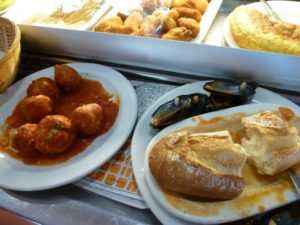
Albondigas (meatballs) in Barcelona
Tapas and other Famous things…
These come in all sorts of shapes, sizes and varieties, especially in cosmopolitan centres such as Madrid and Barcelona. Some common ingredients include albóndigas (meatballs), boquerones (anchovies) and patatas (potatoes). This last option you will find in the popular patatas bravas, which are fried potato cubes served with a hot sauce, or mayonnaise. Larger servings of tapas are known as raciones, while tapas are known as pintxos (pronounced ‘pinchos’) in Basque country.
While found all over Spain, and having gained international recognition, jamón (cured ham) finds its main home in southern and south-western Spain.
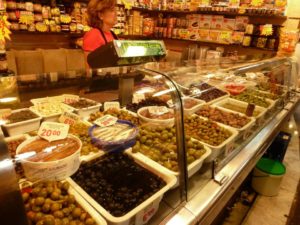
Why can’t we have these kind of delis on every corner in Melbourne?
Valencia is the home of Paella. Originally, paella was made from whatever the farmers could find to put in it (rabbit, chicken, snails). While paella of this variety is still around, its most famous and modern incarnation is that of the famous rice and seafood (or chicken) dish that is found all over the world today. There are few things more alluring than the sight of a giant paella being cooked on coals in the town square (plaza), as people sing and party into the evening.

Pouring cider in the street in Asturias. Not actually in the street…you know what I mean.
Northern Spain
The north offers an amazing array of food options, such as fabada asturiana (a bean and wild boar stew). Another common sight in the province of Asturias is that of people raising their cider bottles high and pouring the dry-tasting liquid into glasses to oxygenate the drink.
Next up, we turn from the most famous street foods of Spain and the Americas, and look at everyday food at home and in the everyday local environment. We’ll also take a look at food customs and celebrations in the Hispanic world. Make sure to continue the journey!
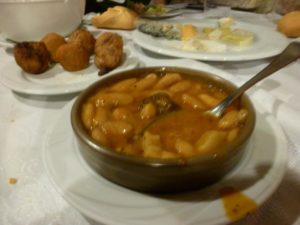
Fabada asturiana…..nice.
